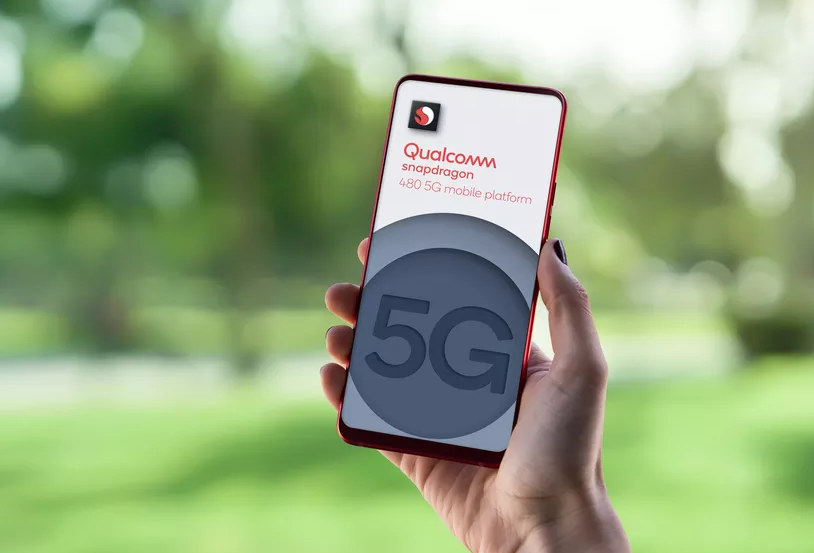
5G rollout really only started ramping in 2019, and we covered premium 5G mobile SoC like Qualcomm Snapdragon 855, Huawei Kirin 990 or Samsung Exynos 980, as soon as December 2018. In late 2019 and 2020, 5G came to mid-range mobile devices thanks to chips such as Snapdragon 765(G), MediaTek Dimensity 720, UNISOC T7520, and others.
Somehow, 5G still felt premium to me since the technology is still relatively, so I was surprised by the level of coverage in Europe and the US, and even smaller countries like Thailand, when I looked at the 5G coverage map above after seeing an announcement for Snapdragon 480 processor designed for entry-level 5G smartphones.
Qualcomm Snapdragon 480 (SM4350) key features and specifications:
- CPU – Octa-core Kryo 460 processor with two Cortex-A76 class cores @ 2.0 GHz, six Cortex-A55 cores @ 1.8 GHz
- GPU – Adreno 619 GPU with H.264 (AVC), H.265 (HEVC) VP8 and
VP9 playback;, API Support: OpenGL ES 3.2, OpenCL 2.0, Vulkan 1.1 - DSP – Hexagon 686 DSP with Hexagon Vector eXtensions and scalar accelerator
- Qualcomm Sensing Hub – Ultra-low-power hub for audio, voice, and sensors
- AI Engine – Comprised of CPU, CPU, Hexagon DSP, and Sensing Hub combo
- Memory – 2×16 LP4x @ 2133 MHz
- Storage – eMMC, UFS 2.2
- Display
- On-Device Display Support:
- FHD+ (1080 x 2520 @ 120 Hz)
- HD+ (900 x 1600 @ 90 Hz)
- External display apparently not supported
- On-Device Display Support:
- Camera
- Qualcomm Spectra 345 ISP (Image Signal Processor)
- Up to 64 MP photo capture
- Up to 13 MP triple camera with 30 FPS Zero Shutter Lag and Multi-Frame Noise Reduction
- Up to 25 MP + 13 MP dual camera with 30 FPS Zero Shutter Lag and Multi-Frame
- 1080p single video capture @ 60 FPS, 720p triple video capture @ 30 FPS
- Slow Motion video capture 720p @ 120 FPS
- 1080p dual video capture @ 30 FPS
- HEIC photo capture, HEVC video capture
- Audio
- Qualcomm Aqstic audio codec (Up to WCD9385)
- Total Harmonic Distortion + Noise (THD+N), Playback: -108dB
- Native DSD support, PCM up to 384 kHz/32-bit
- DSP offload for low power audio playback (Bluetooth, USB digital, analog out)
- Qualcomm Aqstic audio codec (Up to WCD9385)
- Connectivity
- Cellular
- Snapdragon X51 5G Modem-RF System
- Multimode support – 5G NR, LTE including CBRS, WCDMA, HSPA, TD-SCDMA, CDMA 1x, EV-DO, GSM/EDGE
- 5G mmWave and sub-6 GHz, standalone (SA) and non-standalone (NSA) modes, FDD, TDD
- mmWave: 200 MHz bandwidth, 2×2 MIMO
- Sub-6 GHz: 100 MHz bandwidth, 4×4 MIMO
- Qualcomm 5G PowerSave
- Global 5G multi-SIM
- Downlink – Up to 2.5 Gbps (5G), 800 Mbps (LTE)
- Uplink – Up to 660 Mbps (5G), 210 Mbps (LTE)
- WiFi
- WiFi 6-ready, 802.11ac Wave 2, 802.11a/b/g/n with 8-stream sounding, MU-MIMO, Target Wake Time (TWT)
- Wi-Fi Security: WPA3-Enterprise, WPA3-Enhanced Open, WPA3 Easy Connect, WPA3-Personal
- Integrated Bluetooth 5.1 with TrueWireless and AptX adaptive audio support
- Location – Beidou, Galileo, GLONASS, NavIC, GPS, GNSS, QZSS, SBAS
- Near Field Communications (NFC) support
- Cellular
- USB – USB Type-C
- Security
- Qualcomm Mobile Security, Qualcomm Processor Security, Secure Boot, FIPS-certified Hardware Crypto Cores, Hardware Key Manager
- Qualcomm Trusted Execution Environment (QTEE), Camera Security Framework, Trusted UI Framework, Qualcomm Malware Protection to enable biometric authentication, digital payments, and more.
- Qualcomm Content Protection, Wireless Connection Security (Cellular & WiFi), Qualcomm Wireless Edge Services (WES)
- Charging – Quick Charge 4+ technology
- 8 nm Process Technology
Entry-level in 2021 is not what it used to be with Cortex-A76 cores, UFS storage, LPDDR4x memory, and 8nm manufacturing process, besides 5G and WiFi 6 connectivity. Snapdragon 480 is said to deliver up to 100% performance improvement in CPU and GPU, as well as up to 70% AI performance improvement compared to the previous generation, which should be Snapdragon 460 processor announced just one year ago.
We’ve previously seen Snapdragon X51 in the mid-range Snapdragon 690 5G processor, and the downlink and uplink numbers, and other modem specs appear to be exactly the same in Snapdragon 480, so we should expect the same cellular networking in the entry-level 5G phones compared to the mid-tier devices powered by Snapdragon 690.
Snapdragon 480 phones are expected in early 2021 from companies such as HMD Global (Nokia). OnePlus, OPPO, Vivo, and others. More details may be found in the press release and product page.

Jean-Luc started CNX Software in 2010 as a part-time endeavor, before quitting his job as a software engineering manager, and starting to write daily news, and reviews full time later in 2011.
Support CNX Software! Donate via cryptocurrencies, become a Patron on Patreon, or purchase goods on Amazon or Aliexpress





Quad-A76 in entry level, and we’re still waiting for RK3588 🙂
Dual only and hexa a55
oh you’re right, I don’t know how I misread this, I was pretty sure I’d read quad!
Octacore w/ 2 groups…
Also had to read twice 😉
What the coverage maps don’t show you is that 5G feels just like 4G to most users at this point. To achieve anything significantly faster requires close proximity to a cell tower that most users don’t have and may not have for years to come.
Let’s see if VoNR will be allowed universally or if it’s the same crap as with VoLTE…
Here you always drop out of 4G to 3G when on a call. And thanks to spectrum refarming from 3G to 5G the voice coverage gets more and more spotty, while 4G is OK.
My Handset works perfectly on VoLTE (tried with JIO) but here in Europe the operators won’t allow handsets not bought through them in VoLTE…
Impressive specs for an entry level chipset! I hope they price it right.
wifi 6 not 6e?
Entry level.